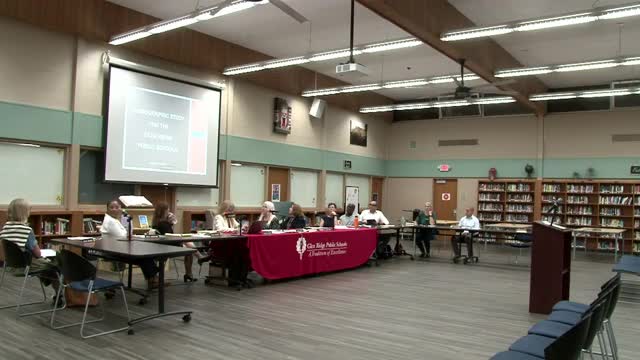Demographer: Glen Ridge enrollment likely to hold near current levels but shift by grade over five years
October 08, 2025 | Glen Ridge Public School District, School Districts, New Jersey
This article was created by AI summarizing key points discussed. AI makes mistakes, so for full details and context, please refer to the video of the full meeting. Please report any errors so we can fix them. Report an error »

Richard Grip, a demographer with the firm Statistical Forecasting, told the Glen Ridge Board of Education that districtwide enrollment will be roughly steady over the next five years but uneven by grade level.
Grip said the district’s five‑year projection shows modest increases in pre‑K through 2 enrollment this year before a gradual decline, driven by inward migration of families with young children and smaller cohorts moving through grades 3–12. “Enrollments are projected to increase this current year… before reversing trend and slowly declining,” Grip said.
The presentation explained the methods and data used: historical October 15 enrollments, 10 years of grade‑to‑grade cohort survival ratios, and birth counts from the New Jersey Department of Health aggregated at the census‑block level. Grip said the district’s total enrollment decreased by about 152 students in the last decade (from about 1,897 in 2015–16 to roughly 1,745 in 2024–25) and that most cohort‑progression ratios indicate net inward migration.
He emphasized birth counts as a key driver of future kindergarten classes. Glen Ridge recorded between 51 and 77 births per year from 2010–2023, with 70 births in both 2010 and 2023. Grip presented birth‑to‑kindergarten ratios that have historically been well above 1.0—indicating families move into town with school‑age children—but noted those ratios have declined in the three years after the pandemic.
Grip also mapped births by elementary attendance zone and said the largest concentrations of recent births were in the central and Linden Avenue attendance areas. Using school capacity figures from the district’s long‑range facilities plan (an operational, not fire‑code, capacity based on current program use), Grip reported that most district schools currently show surplus seating; Ridgewood Avenue felt tight now, and by the five‑year horizon Central School and Ridgewood Avenue could show seating shortages while other schools remain in surplus.
Board members asked whether the declining enrollment mirrored town population changes; Grip said the district trend tracks parts of the community’s age‑structure shifts seen in the 2010 and 2020 census data but is also influenced by inward migration of families. He noted that 10 of 13 grade progressions averaged above 1.0 (net inward migration) while lower values at high‑school grades reflect some families choosing private high school options.
Grip cautioned that projected impacts of future housing developments could not be estimated because the town had no approved developments before the planning board to provide bedroom distribution or site plans. He also noted state data limitations: birth data at the block level for 2022–23 had known errors and were omitted from the attendance‑area aggregation.
The board did not take formal action on the demographic presentation; members thanked Grip and said they would follow up with any additional questions.
Grip said the district’s five‑year projection shows modest increases in pre‑K through 2 enrollment this year before a gradual decline, driven by inward migration of families with young children and smaller cohorts moving through grades 3–12. “Enrollments are projected to increase this current year… before reversing trend and slowly declining,” Grip said.
The presentation explained the methods and data used: historical October 15 enrollments, 10 years of grade‑to‑grade cohort survival ratios, and birth counts from the New Jersey Department of Health aggregated at the census‑block level. Grip said the district’s total enrollment decreased by about 152 students in the last decade (from about 1,897 in 2015–16 to roughly 1,745 in 2024–25) and that most cohort‑progression ratios indicate net inward migration.
He emphasized birth counts as a key driver of future kindergarten classes. Glen Ridge recorded between 51 and 77 births per year from 2010–2023, with 70 births in both 2010 and 2023. Grip presented birth‑to‑kindergarten ratios that have historically been well above 1.0—indicating families move into town with school‑age children—but noted those ratios have declined in the three years after the pandemic.
Grip also mapped births by elementary attendance zone and said the largest concentrations of recent births were in the central and Linden Avenue attendance areas. Using school capacity figures from the district’s long‑range facilities plan (an operational, not fire‑code, capacity based on current program use), Grip reported that most district schools currently show surplus seating; Ridgewood Avenue felt tight now, and by the five‑year horizon Central School and Ridgewood Avenue could show seating shortages while other schools remain in surplus.
Board members asked whether the declining enrollment mirrored town population changes; Grip said the district trend tracks parts of the community’s age‑structure shifts seen in the 2010 and 2020 census data but is also influenced by inward migration of families. He noted that 10 of 13 grade progressions averaged above 1.0 (net inward migration) while lower values at high‑school grades reflect some families choosing private high school options.
Grip cautioned that projected impacts of future housing developments could not be estimated because the town had no approved developments before the planning board to provide bedroom distribution or site plans. He also noted state data limitations: birth data at the block level for 2022–23 had known errors and were omitted from the attendance‑area aggregation.
The board did not take formal action on the demographic presentation; members thanked Grip and said they would follow up with any additional questions.
View full meeting
This article is based on a recent meeting—watch the full video and explore the complete transcript for deeper insights into the discussion.
View full meeting
